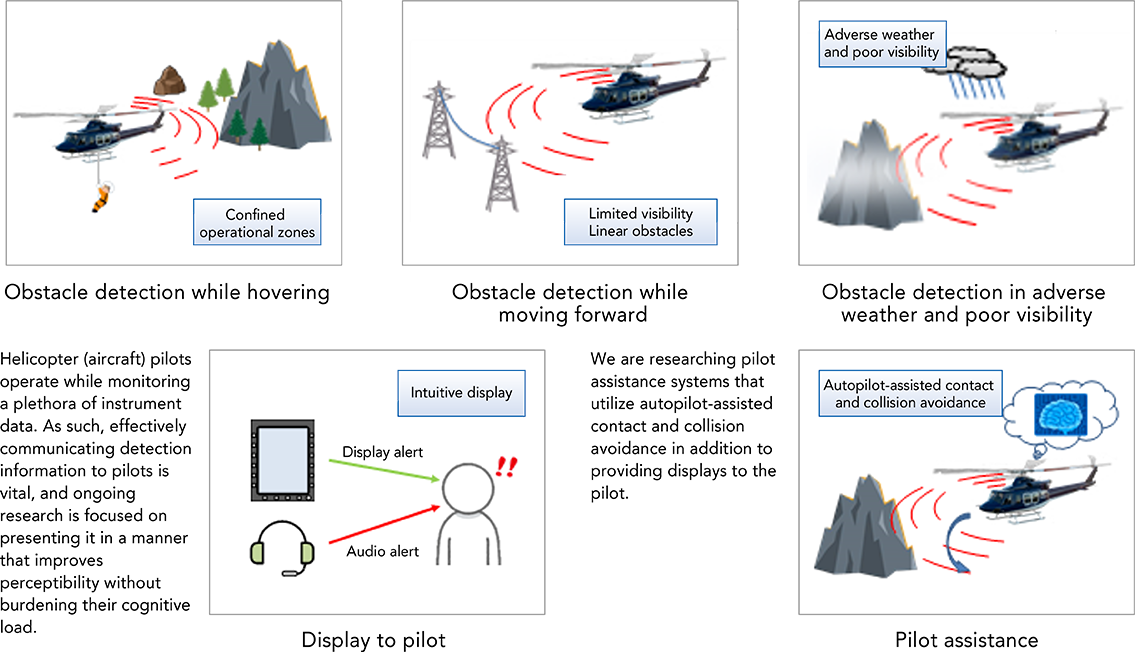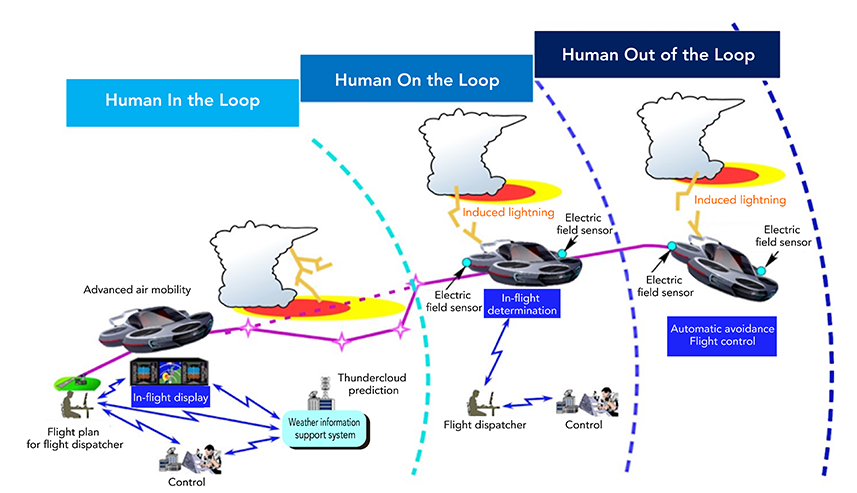Initiatives in the Aerospace Business
SUBARU has created a future vision and technology roadmap for obstacle detection systems and lightning-resistant technology with the aim of developing safety technology for aircraft to detect and avoid obstacles and lightning strikes. Moving forward, we will continue to provide safety and peace of mind in the skies through our obstacle detection systems and lightning-resistant technology.
Research on Obstacle Detection Systems
for Ensuring Helicopter Flight Safety
Helicopters possess distinctive capabilities such as hovering and the ability to take off and land without requiring a runway, unlike fixed-wing aircraft. These traits are crucial for rescue operations in disaster-stricken areas and mountainous terrain, where tasks in confined spaces surrounded by obstacles such as trees, transmission towers, and cliffs are often required. In areas surrounded by obstacles, factors such as changing wind direction and reduced visibility can inadvertently lead to unintended approaches toward these obstacles. In the worst-case scenario, there’s a possibility of contact and even a crash, highlighting the increased awareness of the hazards posed by obstacles.
Various safety devices are incorporated into aircraft, including helicopters, enabling them to detect and avoid a range of hazards. However, they may not cover all potential risks. For this reason, SUBARU is actively engaged in the research and development of obstacle detection systems as part of efforts to eliminate collision accidents.
Obstacle detection systems utilize sensors to detect surrounding obstacles in real-time, particularly in situations with narrow spaces or potential collision risks during adverse weather or poor visibility conditions. They alert the pilot through display and auditory warnings, providing assistance for safe avoidance maneuvers. In the future, the aim is to achieve pilot assistance that enables automatic maneuvering to avoid detected obstacles.
Obstacle Detection System

Research on Lightning Avoidance Systems for Aircraft and
Next-Generation Mobility
In recent years, there has been a growing emphasis on the development of advanced air mobility projects, such as flying cars and drone deliveries, contributing to a potential increase in airborne mobility. However, as cars also take to the skies, approaching thunderclouds can lead to an increase in electric fields, raising the potential for lightning strikes. Modern aircraft are engineered to maintain safe flight even in the event of lightning strikes. Nevertheless, the areas impacted by lightning strikes necessitate repairs, prompting the pursuit of technologies that either mitigate damage or prevent lightning strikes entirely. SUBARU is actively engaged in research aimed at avoiding lightning strikes, which can also be applied to advanced air mobility solutions.
Weather data may detect the distribution of thunderclouds, but accurately predicting where lightning will strike remains challenging. As a result, there is a growing need for aircraft to possess systems capable of preemptively detecting and avoiding lightning. SUBARU partnered with Japan Aerospace Exploration Agency (JAXA) to conduct experiments and analyses on discharge characteristics concerning aircraft model simulations. This research revealed the potential for variations in the susceptibility of lightning strikes based on the direction of lightning, the aircraft’s angle, and the generation of static electricity on the aircraft. In addition, an algorithm has been developed that uses sensor information installed on the aircraft to predict lightning strikes on the aircraft’s surface. Moving forward, the focus will be on verifying this algorithm and refining it to offer supportive information to pilots. Additionally, the aim is to develop and offer aircraft designed to avoid lightning strikes by controlling the aircraft’s state, encompassing advanced air mobility solutions.
Steps from Lightning Prediction to Lightning Avoidance

